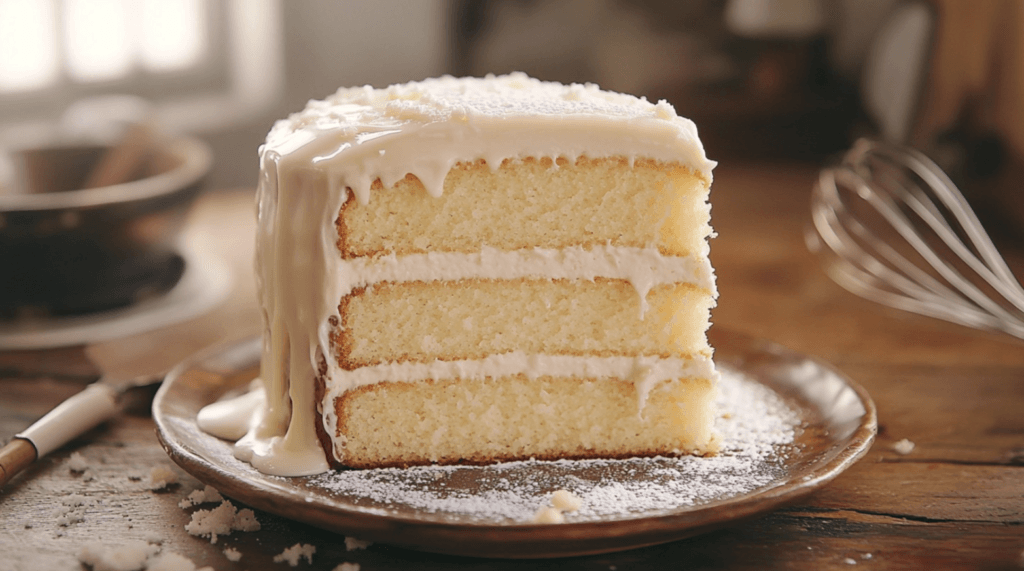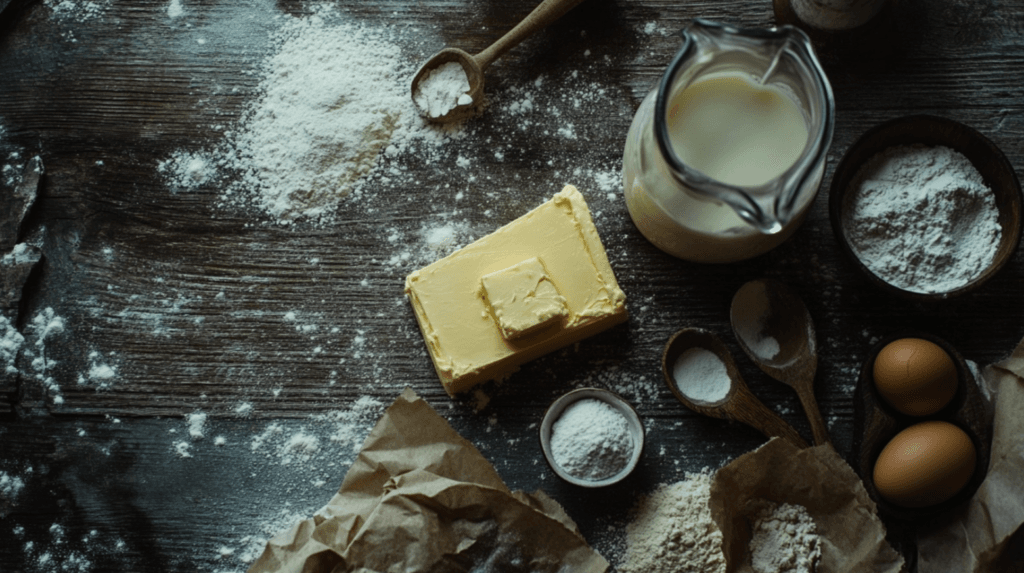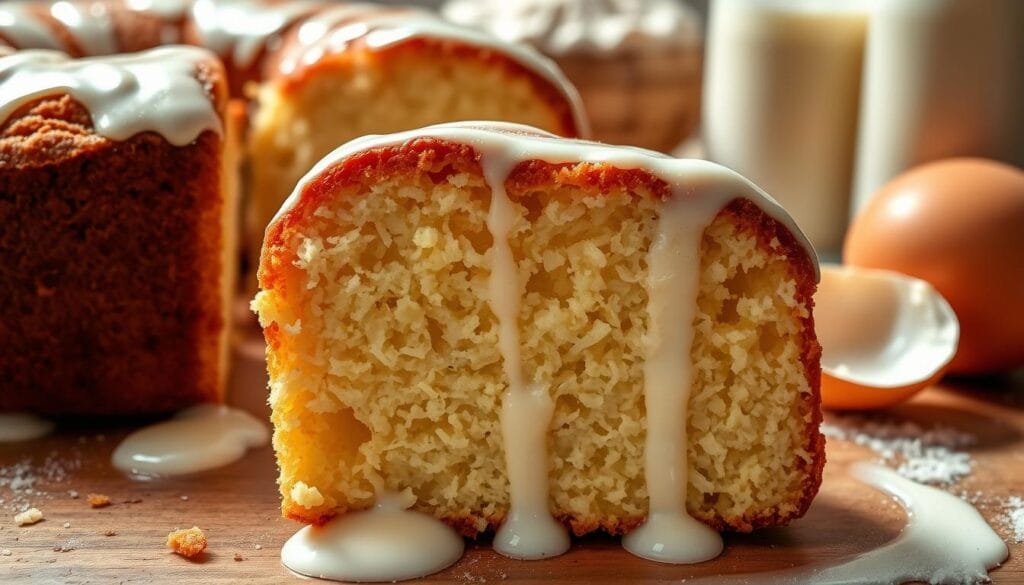I love baking at home and always wanted to make the moistest cakes. After many tries, I discovered the secret. What is the secret to super moist cake? Baking a perfect cake is like an art. Once you learn the science, you’ll get amazing results. Say goodbye to dry cakes and hello to moist, tender ones. It’s a game-changer
Understanding the Science Behind Moist Cake
Baking a moist cake is more than just a recipe. It’s about knowing the science of ingredients and baking. Let’s explore how fats and proteins affect cake texture.
Role of Fats in Cake Moisture
Fats like butter or oil keep cakes moist. They cover flour particles, stopping them from soaking up too much liquid. This makes the cake tender and moist, avoiding a dry texture.
Impact of Protein Content on Texture
The flour type in a recipe changes the cake’s texture. Cakes with cake flour are lighter and fluffier. This is because cake flour has less protein, leading to less gluten. This means the cake stays moist and soft.
Chemical Reactions During Baking
Cake science is also about baking chemistry. Leavening agents like baking soda make the batter light. The Maillard reaction adds rich flavors and a moist texture.

Knowing cake science helps you choose better ingredients and techniques. This ensures your cakes are always tender and moist.
Essential Ingredients for a Super Moist Cake
To make a moist cake, you need to pick the right ingredients. Cake flour is key because it’s finely ground. It makes the cake soft and tender. Sugar, both white and brown, helps keep the cake moist. It absorbs and holds water while baking.
Eggs are vital for the cake’s structure, richness, and moisture. The fat content, like butter or oil, affects the cake’s texture and how moist it stays. Butter adds flavor, while oil keeps the cake moist and tender.
Leavening agents, like baking powder or baking soda, make the cake rise. They help it stay moist and light. Using full-fat dairy products, like whole milk or buttermilk, also makes the cake moist and tender.
| Ingredient | Role in Moist Cake |
|---|---|
| Cake Flour | Provides a soft, tender crumb |
| Sugar (Granulated and Brown) | Retains moisture by absorbing water molecules |
| Eggs | Contribute structure, richness, and moisture |
| Butter or Oil | Affects texture and moisture level |
| Baking Powder or Baking Soda | Responsible for rise and lift, contributing to moist texture |
| Whole Milk or Buttermilk | Enhance moistness and create a tender crumb |
By mixing these ingredients carefully, you can make a moist and delicious cake.

What is the Secret to Super Moist Cake
Creating a moist, tasty cake is all about the right ingredients and methods. Buttermilk’s magic and the oil vs. butter debate are key. Knowing how each part works can make your cake incredibly moist. Get the secret to super moist cake.
Buttermilk as a Key Moisturizing Agent
Buttermilk changes the game for cake moisture. Its acidity softens the gluten, making the cake tender and moist. It also makes the cake rise and stay light.
Oil vs. Butter Debate
Butter adds great flavor, but oil keeps the cake moist. Oil stays liquid, keeping the cake moist. Using both oil and butter gives you the best of both worlds.
Role of Simple Syrup
Professional bakers use simple syrup to keep cakes moist. This sweet liquid adds moisture to the cake. You can flavor it with extracts or citrus zest for extra taste.
By learning about moist cakes and using these tips, you can make amazing, moist cakes. They will impress your family and friends.

Proper Measuring Techniques for Perfect Results about the moist cakes.
Getting baking measurements right is key to making moist cakes. Whether you’re new or experienced, learning to measure ingredients well is crucial. We’ll talk about why being precise is important and give tips for moist cakes every time.
Measuring dry ingredients, like flour, is very important. Using a kitchen scale helps avoid overpacking. This ensures your cake batter has the right mix of dry and wet parts. For wet ingredients, like milk or oil, use liquid measuring cups.
Knowing the right ways to measure can improve your baking measurements. The spoon and level method for flour helps avoid packing. It ensures you get the right amount. Also, how you pack brown sugar affects your cake’s moisture.
| Ingredient | Measuring Technique |
|---|---|
| Flour | Use a kitchen scale or the spoon and level method |
| Liquid Ingredients | Use clear liquid measuring cups |
| Brown Sugar | Pack the sugar firmly into the measuring cup |
Measuring ingredients accurately is not just for texture. It’s also for flavor balance in your cakes. By mastering these methods, you’ll make cakes that wow everyone. Remember, baking accuracy is the secret to moist cakes.

Temperature Matters: Room Temperature Ingredients
When baking the perfect cake, ingredient temperature is key. Using room temperature ingredients is crucial for the right texture. Let’s explore why temperature matters for your cake.
Why Room Temperature Eggs Matter
Eggs are vital in cake recipes. Their temperature greatly affects the result. Room-temperature eggs mix better, making the batter smooth and even.
Butter Temperature Guidelines
Butter is also important in moist cakes. It should be cool but soft. This makes it blend well with other ingredients, avoiding tough cake.
Dairy Products Temperature Tips
Dairy like milk and buttermilk should be at room temperature too. This helps them mix smoothly, preventing lumps and ensuring even baking.
| Ingredient | Ideal Temperature |
|---|---|
| Eggs | Room temperature |
| Butter | Cool to the touch, but pliable |
| Dairy products (milk, buttermilk) | Room temperature |
By focusing on ingredient temperature, you can make a moist, bakery-quality cake. Properly tempered ingredients mix better, avoiding tough cake.
Mixing Methods and Their Impact on Moisture
Mixing your cake right is key to a moist and tender treat. Overmixing can make your cake tough and dry. This happens because it builds up gluten, a protein in flour.
To avoid this, mix the dry and wet ingredients just until they blend. Don’t overdo it.
When using a stand mixer, choose the paddle attachment. It mixes more gently. This helps prevent too much gluten from forming. For an even gentler touch, fold the ingredients by hand with a spatula. This keeps your cake light and airy.
- Avoid overmixing the batter to prevent a tough, dry cake texture.
- Use a paddle attachment on your stand mixer for gentler mixing.
- Fold in ingredients by hand with a spatula for the most delicate mixing.
The batter’s consistency is very important. The right mix of dry and wet ingredients, along with the right mixing, makes a cake that’s moist and tender. By learning these cake mixing techniques, you’ll make a moist cake every time.
| Mixing Method | Impact on Cake Moisture |
|---|---|
| Overmixing | Develops gluten, leading to a tough, dry cake texture |
| Paddle Attachment on Stand Mixer | Mixes gently, preventing excessive gluten formation |
| Folding by Hand | Most delicate approach, maintaining a light and airy texture |
Optimal Baking Temperature and Timing.
To get the perfect cake, you need to know the best baking temperature and time. The usual temperature is about 180 degrees Celsius (350 degrees Fahrenheit). Baking time is usually 30 to 40 minutes.
Make sure to preheat your oven for 20 to 30 minutes before baking. This helps the cake rise and get the right structure.
Using an Oven Thermometer
Don’t trust your oven’s temperature display too much. An oven thermometer is a better choice. It ensures your oven is at the right temperature for baking.
Signs of Perfect Doneness
Figuring out when your cake is done can be hard. But, there are signs to look for. Start checking at the minimum baking time.
A cake is done when a toothpick in the center comes out clean or with a few moist crumbs. Be careful not to overbake, as it can make the cake dry and crumbly.
| Cake Type | Ideal Internal Temperature |
|---|---|
| Fudgy or Dense Cakes | 200-205°F |
| Lighter Cakes | 210°F |
Chef Jake Cohen says the best internal temperature for a moist cake is 200 to 210 degrees Fahrenheit. Fudgy cakes need 200-205 degrees, while lighter cakes should reach 210 degrees.
Pan Selection and Preparation Tips
Getting a super moist cake starts with the right pan. The pan you pick can change how your cake turns out. Let’s look at what to consider when picking and preparing your pan for a great bake.
Choosing the Right Cake Pans: The secret to super moist cake.
- Aluminum Pans: They conduct heat well, making baking even and browning uniform.
- Stainless Steel Pans: Not as good at heat conduction but durable and easy to clean.
- Silicone Pans: They’re non-stick and flexible but need extra support to avoid warping.
- Glass Pans: Heat slowly and evenly, good for casseroles and desserts.
- Non-Stick Coated Pans: Easy to release cakes but may wear out over time.
Proper Pan Preparation
Right pan prep is key for a moist cake. Here are some tips:
- Grease and flour pans or use parchment paper to prevent sticking.
- Use baking strips around pans for even baking and to stop domes.
- Make sure pans match the recipe size to avoid problems.
- Adjust baking time for different pan sizes for consistent results.
| Cake Pan Type | Commonly Used For | Advantages | Considerations |
|---|---|---|---|
| Round Pans | Layer Cakes | Classic shape, easy to frost and assemble | Ensure even baking and cooling |
| Square/Rectangular Pans | Sheet Cakes, Brownies, Bar Cookies | Versatile, easy to cut and serve | Distribute batter evenly for consistent results |
| Bundt Pans | Pound Cakes, Dense Cakes | Unique shape, great for glazing or dusting | Allow cake to cool completely before inverting |
| Springform Pans | Cheesecakes, Delicate Cakes | Easy release, perfect for layered or molded cakes | Ensure proper sealing to prevent leaks |
| Specialty Pans | Themed Cakes | Unique shapes and designs for celebrations | Adjust baking time and temperature as needed |
By picking the right cake pans and preparing them well, you’ll bake moist cakes that wow your guests and please your taste buds.
Storage Solutions for Maintaining Moisture
Keeping your cakes fresh and moist is all about proper storage. Let your cakes cool down completely before you store them. For cakes without frosting, wrap them tightly in plastic wrap or use airtight containers.
This method stops cakes from drying out and losing moisture. For longer storage, freezing is a great option. Wrap your cakes in plastic and then foil to keep them fresh.
When you’re ready to eat them, thaw the cakes in the fridge. This prevents moisture from making them soggy an additional secret to super moist cake.
| Cake Storage Tip | Duration |
|---|---|
| Unfrosted cakes, wrapped in plastic | Up to 1 week at room temperature |
| Frosted cakes, covered in a cake keeper | 4-5 days at room temperature |
| Frozen cakes, wrapped in plastic and foil | 2-3 months in the freezer |
Once a cake is cut, it dries out and becomes stale quicker. To keep your cake fresh, cover the cut edges with frosting. Or press plastic wrap right onto the exposed area before storing.
By using these cake storage tips, your homemade cakes will stay moist and tasty for a long time. Storing cakes right is key to keeping their great texture and flavor.
Common Mistakes That Lead to Dry Cakes
Baking a moist cake is tricky. Even small mistakes can make it dry and crumbly. It’s important to watch out for common errors that can dry out your cakes. From how you prepare ingredients to mixing and oven settings, each step is key to a moist cake.
One big mistake is over-mixing the batter. This activates gluten, making the cake dense and tough. Also, using the wrong pan size or material can mess up heat distribution. This can cause uneven baking and dryness.
Changing ingredients without adjusting can also dry out your cake. For example, using less sugar or low-fat ingredients can make it drier. And, not letting eggs, butter, and dairy get to room temperature before mixing can also affect the cake’s moisture.
- Overmixing the batter, leading to tough, dense texture
- Incorrect pan size or material, causing uneven baking and dryness
- Substituting ingredients without proper adjustments, such as reducing sugar or using low-fat options
- Failing to bring ingredients to room temperature before mixing
Being precise is crucial in baking. Paying attention to details like oven temperature, pan preparation, and the toothpick test can help avoid dry cakes. By avoiding these common mistakes, you’ll make moist, tasty cakes that everyone will love and ask for the secret to super moist cake
| Mistake | Impact on Cake Moisture |
|---|---|
| Overmixing batter | It develops too much gluten, leading to a tough, dense texture |
| Using incorrect pan size or material | Causes uneven heat distribution and baking, resulting in dryness |
| Substituting ingredients without adjustments | Reducing sugar or using low-fat options can result in a drier crumb |
| Failing to bring ingredients to room temperature | It affects the proper mixing and development of texture |

Conclusion
Every baker dreams of a super moist cake. By knowing the science of baking, you can make cakes that are soft, tender, and full of flavor. It’s all about choosing the right ingredients and mastering the baking process.
Using high-quality fats and understanding chemical reactions is crucial. Also, avoid over-mixing to keep your cakes moist. Adding buttermilk, sour cream, or instant pudding mix can make them even better.
With practice and following these moist cake tips, you’ll get better at cake-baking success. Use the baking techniques you like and that fit your needs. When you know the science and use the right methods of the secret to super moist cake.
FAQ
What is the secret to a super moist cake?
To make a super moist cake, you need to know some baking secrets. Use full-fat dairy products and measure ingredients correctly. Make sure your ingredients are at room temperature and don’t overmix.
Sugar, fats, and liquids are key to keeping the cake moist.
How do fats and proteins affect cake texture?
Fats help prevent the flour from absorbing too much liquid. This makes the cake soft and not tough. The type of protein in the flour also matters.
Flours with less protein, like cake flour, make cakes light and fluffy. Baking involves chemical reactions that add moisture and flavor.
What are the essential ingredients for a moist cake?
For a moist cake, you need flour, sugar, eggs, fat, and leavening agents. Use whole milk or buttermilk for extra moisture. Brown sugar adds moisture because of its molasses.
How does buttermilk, oil, and simple syrup contribute to cake moisture?
Buttermilk makes the cake tender and moist. Oil keeps the cake moist longer than butter. Using both oil and butter adds flavor and moisture.
Brushing simple syrup on the cake layers adds moisture and flavor.
Why is accurate measurement critical in baking?
Accurate measurement is very important in baking. Use a kitchen scale for dry ingredients like flour. Liquid measuring cups are best for wet ingredients.
Getting the right balance of ingredients is key for a moist cake.
Why are room-temperature ingredients important?
Ingredients at room temperature mix better and reduce overmixing risk. Eggs and softened butter should be at room temperature. This makes the batter smooth and bakes evenly.
How does proper mixing technique affect cake moisture?
Mixing correctly is crucial for a moist cake. Overmixing can make the cake tough and dry. Mix dry and wet ingredients until just combined.
Use a paddle attachment for gentle mixing. Folding ingredients by hand helps keep the texture right.
What factors impact proper baking temperature and timing?
The right oven temperature is essential for even baking. Use an oven thermometer for accuracy. Start checking for doneness at the minimum baking time.
A cake is done when a toothpick comes out clean or with a few moist crumbs. Avoid overbaking to keep the cake moist.
How should cake pans be prepared for optimal baking results?
Use light-colored metal pans for even baking. Dark pans may need a lower temperature. The right pan size is important for even baking and moisture.
Grease and flour pans or use parchment paper to prevent sticking. Baking strips can help with even baking.
How should cakes be stored to maintain moisture?
Storing cakes properly is key to keeping them moist. Cool cakes completely before storing. Wrap unfrosted cakes tightly in plastic wrap or store them in airtight containers.
For longer storage, freeze cakes wrapped in plastic wrap and aluminum foil. Thaw frozen cakes in the fridge to avoid condensation.
What are common mistakes that lead to dry cakes?
Common mistakes include overmixing, using the wrong pan size, overbaking, and substituting ingredients without adjusting. Low-fat ingredients can also make cakes dry.
Inaccurate oven temperatures and opening the oven door too often can also affect moisture.

